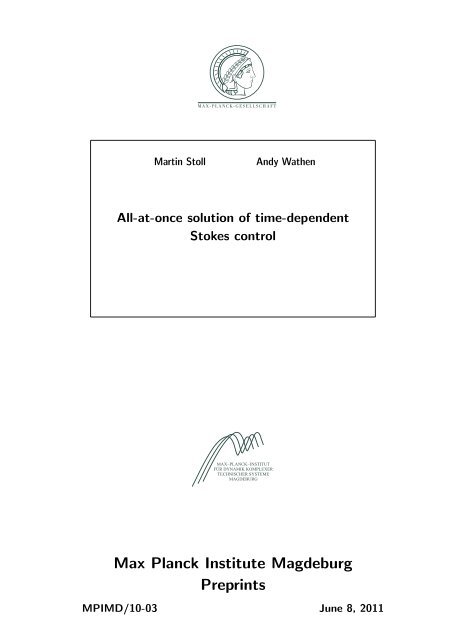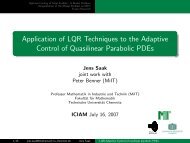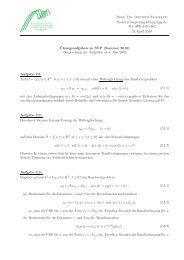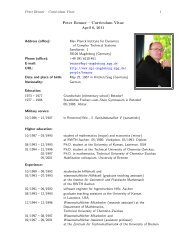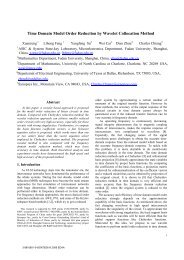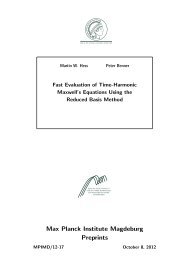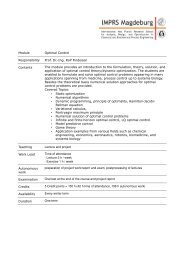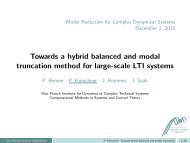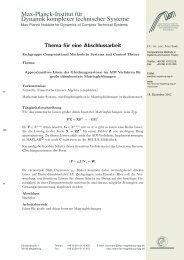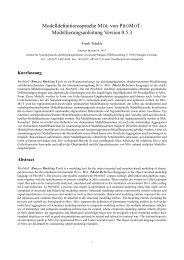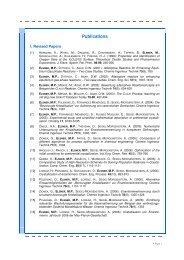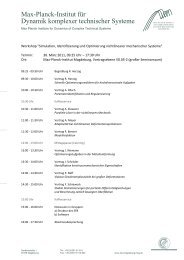Martin Stoll, Andy Wathen (Oxford): All-at-once - Max Planck Institute ...
Martin Stoll, Andy Wathen (Oxford): All-at-once - Max Planck Institute ...
Martin Stoll, Andy Wathen (Oxford): All-at-once - Max Planck Institute ...
You also want an ePaper? Increase the reach of your titles
YUMPU automatically turns print PDFs into web optimized ePapers that Google loves.
<strong>Martin</strong> <strong>Stoll</strong> <strong>Andy</strong> <strong>W<strong>at</strong>hen</strong><br />
<strong>All</strong>-<strong>at</strong>-<strong>once</strong> solution of time-dependent<br />
Stokes control<br />
MAX−PLANCK−INSTITUT<br />
FÜR DYNAMIK KOMPLEXER<br />
TECHNISCHER SYSTEME<br />
MAGDEBURG<br />
<strong>Max</strong> <strong>Planck</strong> <strong>Institute</strong> Magdeburg<br />
Preprints<br />
MPIMD/10-03 June 8, 2011
Impressum:<br />
<strong>Max</strong> <strong>Planck</strong> <strong>Institute</strong> for Dynamics of Complex Technical Systems, Magdeburg<br />
Publisher:<br />
<strong>Max</strong> <strong>Planck</strong> <strong>Institute</strong> for Dynamics of Complex<br />
Technical Systems<br />
www.mpi-magdeburg.mpg.de/preprints<br />
Address:<br />
<strong>Max</strong> <strong>Planck</strong> <strong>Institute</strong> for Dynamics of<br />
Complex Technical Systems<br />
Sandtorstr. 1<br />
39106 Magdeburg
<strong>All</strong>-<strong>at</strong>-<strong>once</strong> solution of time-dependent Stokes control<br />
<strong>Martin</strong> <strong>Stoll</strong> a , <strong>Andy</strong> <strong>W<strong>at</strong>hen</strong> b<br />
a Comput<strong>at</strong>ional Methods in Systems and Control Theory, <strong>Max</strong> <strong>Planck</strong> <strong>Institute</strong> for<br />
Dynamics of Complex Technical Systems, Sandtorstr. 1, 39106 Magdeburg Germany, Tel.:<br />
+49 391 6110 384, Fax: +49 391 6110 500 (martin.stoll80@gmail.com)<br />
b Numerical Analysis Group, M<strong>at</strong>hem<strong>at</strong>ical <strong>Institute</strong>, 24 - 29 St Giles’, <strong>Oxford</strong>, OX1 3LB,<br />
United Kingdom, Tel.: +44 1865 615309, Fax: +44 1865 273583 (w<strong>at</strong>hen@m<strong>at</strong>hs.ox.ac.uk)<br />
Abstract<br />
The solution of time-dependent PDE-constrained optimiz<strong>at</strong>ion problems subject<br />
to unsteady flow equ<strong>at</strong>ions presents a challenge to both algorithms and<br />
computers. In this paper we present an all-<strong>at</strong>-<strong>once</strong> approach where we solve for<br />
all time-steps of the discretized unsteady Stokes problem <strong>at</strong> <strong>once</strong>. The most<br />
desirable fe<strong>at</strong>ure of this approach is th<strong>at</strong> for all steps of an iter<strong>at</strong>ive scheme we<br />
only need approxim<strong>at</strong>e solutions of the discretized Stokes oper<strong>at</strong>or. This leads<br />
to an efficient scheme which exhibits mesh-independent behaviour.<br />
Keywords: Saddle point problems, Unsteady Stokes equ<strong>at</strong>ion,<br />
PDE-constrained optimiz<strong>at</strong>ion, Preconditioning<br />
1. Introduction<br />
The solution of complex flow problems is one of the most interesting and<br />
demandingproblems in applied m<strong>at</strong>hem<strong>at</strong>ics and scientific computing. Overthe<br />
last decades the numerical solution of problems such as Stokes flow has received<br />
a lot of <strong>at</strong>tention both from applied scientist and m<strong>at</strong>hem<strong>at</strong>icians alike. The<br />
discretiz<strong>at</strong>ion of the Stokes equ<strong>at</strong>ion via finite elements [13, 1, 10] as well the<br />
efficient solution of the corresponding linear systems in saddle point form [13,<br />
47, 40, 3] are well established. In recent years, with the advances of computing<br />
power and algorithms, the solution of optimal control problems with partial<br />
differential equ<strong>at</strong>ion (PDE) constraints such as Stokes or Navier-Stokes flow<br />
problems have become a topic of gre<strong>at</strong> interest [22, 25, 35, 7, 12].<br />
In this paper, we want to address the issue of efficiently solving the linear<br />
systems th<strong>at</strong> arise when the optimal control of the time-dependent Stokes problem<br />
is considered. We here want to employ the so-called one-shot approach,<br />
which is a technique previously used in [23, 24, 5, 43]. In detail, the discretiz<strong>at</strong>ion<br />
of the problem is constructed in the space-time domain and then solved for<br />
all time-steps <strong>at</strong> <strong>once</strong>. We will come back to this l<strong>at</strong>er.<br />
The paper is organized as follows, we first discuss the control problem and<br />
how it can be discretized. In Section 3 we discuss the choice of the Krylov solver<br />
th<strong>at</strong> should be employed. We then discuss the preconditioners for the various<br />
Preprint submitted to J Comp Phys June 8, 2011
parts of the saddle point problem. This is followed by numerical experiments<br />
for two different objective functions in both two and three space dimensions and<br />
time.<br />
2. Problem and discretiz<strong>at</strong>ion<br />
In the following we consider the tracking-type functional<br />
T T <br />
J(y,u) = 1<br />
2<br />
0<br />
Ω1<br />
(y − ¯y) 2 dxdt+ β<br />
2<br />
0<br />
Ω2<br />
(u) 2 dxdt+ γ<br />
2<br />
Ω1<br />
(y(T)− ¯y(T)) 2 dx<br />
(1)<br />
where Ω 1/2 ⊆ Ω are bounded domains in R d with d = 2,3. Additionally, for the<br />
st<strong>at</strong>e y and the control u the time-dependent Stokes equ<strong>at</strong>ion has to be s<strong>at</strong>isfied<br />
yt −ν△y +∇p = u in [0,T]×Ω (2)<br />
−∇·y = 0 in [0,T]×Ω (3)<br />
y(t,.) = g(t) on ∂Ω,t ∈ [0,T] (4)<br />
y(0,.) = y0 in Ω, (5)<br />
with y the st<strong>at</strong>e representing the velocity and p the pressure. Here, ¯y is the<br />
so-called desired st<strong>at</strong>e. The goal of the optimiz<strong>at</strong>ion is to compute the control<br />
u in such a way th<strong>at</strong> the st<strong>at</strong>e y will be as close as possible to ¯y. One might<br />
impose additional constraints both on the control u and the st<strong>at</strong>e y. One of the<br />
most common constraints in practice are the so-called box constraints given by<br />
ua ≤ u ≤ ub and ya ≤ u ≤ yb.<br />
We will discuss these l<strong>at</strong>er and for now assume th<strong>at</strong> no-such constraints are<br />
imposed.<br />
There are two techniques used to solve the above problem. The first is the<br />
so-called Discretize-then-Optimize approach and the second is the Optimizethen-Discretize<br />
approach. In the first problem, both the functional and the<br />
PDE are discretized before the optimiz<strong>at</strong>ion typically via a Lagrange multiplier<br />
approachis employed. Optimize-then-Discretizewill first build the KKTsystem<br />
forthe infinite dimensionalproblem. Itisdesirabletohavebothapproacheslead<br />
to the same discrete optimality system.<br />
We begin by considering the first order conditions of the above problem and<br />
get the forward problem described in (2) to (5), the rel<strong>at</strong>ion<br />
βu+λ = 0 (6)<br />
referred to as the gradient equ<strong>at</strong>ion as well as the adjoint PDE<br />
−λt −ν△λ+∇ξ = y − ¯y in [0,T]×Ω (7)<br />
−∇·λ = 0 in [0,T]×Ω (8)<br />
y(t,.) = 0 on ∂Ω,t ∈ [0,T] (9)<br />
y(0,.) = γ(y(T)− ¯y(T)) in Ω, (10)<br />
2
(for more inform<strong>at</strong>ion see [46, 45, 23, 24]).<br />
The question is now whether we can find a discretiz<strong>at</strong>ion-scheme such th<strong>at</strong><br />
the Discretize-then-Optimize and the Optimize-then-Discretize approach coincide.<br />
One central question is how to discretize the above problem. We start by<br />
using a backwardEuler scheme in time to obtain for the forwardStokes problem<br />
and similarly for the adjoint PDE we get<br />
yk −yk−1 −ν△y<br />
τ<br />
k +∇p k = u k<br />
(11)<br />
−∇·y k = 0 (12)<br />
λk −λk+1 −ν△λ<br />
τ<br />
k +∇ξ k = y k − ¯y k<br />
(13)<br />
−∇·λ k = 0 (14)<br />
andforthosetworel<strong>at</strong>ions,afterafinite elementspacediscretiz<strong>at</strong>ion, the m<strong>at</strong>rix<br />
represent<strong>at</strong>ions look like the following<br />
and<br />
My k −My k−1<br />
τ<br />
+νKy k +B T p k = Mu k<br />
(15)<br />
By k = 0 (16)<br />
Mλ k −Mλ k+1<br />
+νKλ<br />
τ<br />
k +B T ξ k = My k −M¯y k<br />
(17)<br />
Bλ k = 0, (18)<br />
with M being the mass m<strong>at</strong>rix (for the sake of simplicity we assume M to be<br />
the lumped mass m<strong>at</strong>rix) and K the finite element stiffness m<strong>at</strong>rix. We will<br />
l<strong>at</strong>er use Mp for the mass m<strong>at</strong>rix on the pressure space but refrain from adding<br />
the index y to the mass m<strong>at</strong>rix on the velocity space.<br />
3
The appropri<strong>at</strong>e one-shot form for the forward PDE is now given by<br />
⎡<br />
L<br />
⎢ −M0 ⎢ 0<br />
⎢<br />
⎣ 0<br />
0<br />
0<br />
L<br />
−M0<br />
0<br />
0<br />
⎡<br />
⎤<br />
y<br />
0 0 0 ⎢<br />
0 0 0 ⎥⎢<br />
⎥⎢<br />
L 0 0 ⎥⎢<br />
⎥⎢<br />
. .. . ..<br />
⎥⎢<br />
0 ⎦ ⎢<br />
0 −M0 L ⎣<br />
0<br />
p0 y1 p1 ⎤<br />
⎥<br />
⎦<br />
⎡ ⎤<br />
M 0 0<br />
⎢ 0 0 0 0 ⎥⎡<br />
⎥<br />
⎢ 0 M 0 0 ⎥<br />
⎥⎢<br />
⎢<br />
−τ ⎢ 0 0 0 0 ⎥⎢<br />
⎥⎢<br />
⎢<br />
.<br />
⎢ 0 0 ..<br />
⎥⎣<br />
0 ⎥<br />
⎣ 0 0 0 0 ⎦<br />
0 0 0 M<br />
.<br />
y N<br />
p N<br />
u 0<br />
u 1<br />
.<br />
u N<br />
⎡<br />
⎤<br />
⎥<br />
⎦ =<br />
⎢<br />
⎣<br />
Ly 0<br />
0<br />
0<br />
0<br />
.<br />
0<br />
0<br />
⎤<br />
⎥<br />
⎦<br />
(19)<br />
(20)<br />
Ky + −τNu + = d, (21)<br />
<br />
T L B<br />
where L = , L = τ<br />
B 0<br />
−1M +K and M0 = blkdiag(τ−1M,0). The scheme presented by (15) and (19) represents a discretiz<strong>at</strong>ion of the<br />
forward PDE, as already pointed out in [43] the adjoint of (19) will represent<br />
the time-evolution described by (17) but the initial condition for the adjoint<br />
PDE might make for a difference between the Discretize-then-Optimize and<br />
Optimize-then-Discretize approaches.<br />
In more detail, the discretiz<strong>at</strong>ion of the functional J(y,u) (using yi, ui, ¯yi<br />
for i = 0,...,N <strong>at</strong> the different time-steps) via a rectangle rule for the time and<br />
finite elements for the space leads to<br />
J(u,y) = τ<br />
2<br />
N<br />
i=1<br />
(yi −¯yi) T M (yi − ¯yi)+ βτ<br />
2<br />
+ γ<br />
2 (yN −¯yN) T Mu(yN −¯yN).<br />
N<br />
i=1<br />
u T i Muui<br />
(22)<br />
Note th<strong>at</strong> N denotes the number of time-steps. In fact, we are using a slightly<br />
different approxim<strong>at</strong>ion<br />
J(u,y) = τ<br />
2<br />
N<br />
i=0<br />
(yi −¯yi) T M (yi − ¯yi)+ βτ<br />
2<br />
+ γ<br />
2 (yN −¯yN) T Mu(yN −¯yN),<br />
N<br />
i=0<br />
u T i Muui<br />
(23)<br />
whichwill l<strong>at</strong>ergiveth<strong>at</strong> the approachesoptimize-then-discretizeand discretizethen-optimize<br />
coincide. Note th<strong>at</strong> this changes the functional J(y,u) only by<br />
4
constant terms involving the initial values for y0, ¯y0 and u0 but the loc<strong>at</strong>ion of<br />
the minimum will not be changed.<br />
The Lagrangian of the discrete problem can now be written as<br />
L(y + ,u,λ + ) = J(y,u)+ λ +T −Ky + +τNu+d <br />
whereweusey + = [y0,p0,...,yN,pN]andsimilarlyforλ + = [λ0,ξ0,...,λN,ξ N].<br />
The first order or KKT conditions for L(y + ,u,λ + ) are now given by the following<br />
system<br />
⎡<br />
⎣<br />
τM 0 −KT<br />
0 βτMu τN T<br />
−K τN 0<br />
⎤⎡<br />
⎦⎣<br />
y +<br />
u +<br />
λ +<br />
⎤<br />
⎦ =<br />
⎡<br />
⎣ M¯y+<br />
0<br />
d<br />
⎤<br />
(24)<br />
⎦. (25)<br />
We will discuss appropri<strong>at</strong>e solvers and possible preconditioners for system (25)<br />
in Section 3.<br />
Our aim now is to discuss the Optimize-then-Discretize approach and how<br />
to ensure it coincides with the Discretize-then-Optimize. Here we follow the<br />
results presented in [23] for the Stokes equ<strong>at</strong>ion (see [24] for Navier-Stokes).<br />
Hinze et al. start with the infinite-dimensional KKT system. A straightforward<br />
discretiz<strong>at</strong>ion of the infinite dimensional problems will in general not result<br />
in agreement of both optimiz<strong>at</strong>ion-discretiz<strong>at</strong>ion approaches. The technique<br />
introduced in [23] starts with a time-discretiz<strong>at</strong>ion of the forward problem as<br />
done in (11) and adjusting the initial condition to be<br />
y0 −τ△y0 = y0 −τ△y0.<br />
Writing down the Lagrangian for the semi-discretized problem we obtain the<br />
following system<br />
yk −yk−1 −ν△y<br />
τ<br />
k +∇p k = u k<br />
(26)<br />
−∇·y k = 0 (27)<br />
y0 −τ△y0 = y0 −τ△y0<br />
(28)<br />
βuk +λk = 0 (29)<br />
λk −λk+1 −ν△λ<br />
τ<br />
k +∇ξ k = y k − ¯y k<br />
(30)<br />
−∇·λ k = 0 (31)<br />
λN −τ△λN = (τ +γ)(yN − ¯yN). (32)<br />
Using standard mixed finite elements to discretize in space we obtain the same<br />
discrete first order system for the Optimize-then-Discretize approach as for the<br />
Discretize-then-Optimizeprocedure. Noteth<strong>at</strong>withthechangeswemadeearlier<br />
to the discretiz<strong>at</strong>ion of the cost functional J(y,u), we get agreement of the<br />
initial values of the Optimize-then-Discretize approach and the Discretize-then-<br />
Optimize procedure.<br />
5
In addition to the above considered problem, we will also discuss the numerical<br />
solution of a PDE-constrained optimiz<strong>at</strong>ion problem th<strong>at</strong> has an added<br />
pressure term in the functional J(y,u), i.e.,<br />
J(y,u) = 1<br />
T<br />
2<br />
+ β<br />
2<br />
0<br />
<br />
T <br />
0<br />
Ω1<br />
Ω<br />
(y − ¯y) 2 dxdt+ ν<br />
T <br />
(p− ¯p)<br />
2 0 Ω1<br />
2 dxdt<br />
(u) 2 dxdt+ γ<br />
<br />
(y(T)− ¯y(T))<br />
2<br />
2 dx<br />
Ω1<br />
(33)<br />
subject to the unsteady Stokes equ<strong>at</strong>ion as shown above. Here p is the pressure<br />
and ¯pisthedesiredpressure. Thediscretiz<strong>at</strong>ionfollowstheaboveprocedureand<br />
the first order conditions L(y + ,u,λ + ) are now given by the following system<br />
⎡<br />
⎣<br />
τM 0 −KT<br />
0 βτMu τN T<br />
−K τN 0<br />
⎤⎡<br />
⎦⎣<br />
y +<br />
u +<br />
λ +<br />
⎤<br />
⎦ =<br />
⎡<br />
⎣ M¯y+<br />
0<br />
d<br />
⎤<br />
⎦, (34)<br />
where the only difference to the system given in (25) is the m<strong>at</strong>rix M =<br />
blkdiag(M,...,M,Mp,...,Mp). Note th<strong>at</strong> for reasons of convenience we will<br />
always use M as a not<strong>at</strong>ion for the (1,1) block whether positive definite or not.<br />
We will specify when it is important to consider the two cases separ<strong>at</strong>ely.<br />
3. Krylov solver and preconditioning<br />
After having derived the linear system corresponding to the solution of the<br />
optimal control problem, we now want to discuss how to solve this system<br />
efficiently. For a reasonable sized sp<strong>at</strong>ial discretiz<strong>at</strong>ion even in two dimensions<br />
a direct solver might run out of memory fairly quickly as the dimensionality<br />
of the overall system crucially depends on the temporal discretiz<strong>at</strong>ion. Hence,<br />
we dismiss the possibility of using a direct solver for the overall system and<br />
r<strong>at</strong>her decide to employ Krylov-subspace solvers. Because of the n<strong>at</strong>ure of the<br />
problem, A being symmetric and indefinite, we will use minres [31] as it is<br />
often the method of choice for saddle point problems. In more detail, minres<br />
(and also other Krylov subspace solvers) will build up a Krylov subspace<br />
span r0,Ar0,A 2 r0,...,A k−1 <br />
r0<br />
by multiplying with the system m<strong>at</strong>rix <strong>at</strong> each step. The approxim<strong>at</strong>ion to the<br />
solution of the linear system will then be computed such th<strong>at</strong> the 2-norm (in<br />
the unpreconditioned case) of the residual rk 2 is minimized over the current<br />
Krylov subspace. N<strong>at</strong>urally, minres will only be used with a preconditioner<br />
and we refer to [13] for implement<strong>at</strong>ion details. In order for the preconditioned<br />
system to maintain the symmetric and indefinite n<strong>at</strong>ure of the problem, we need<br />
the preconditioner to be symmetric and positive definite. Hence, our choice will<br />
be a symmetric block-diagonal preconditioner. Before we mention the details of<br />
the preconditioner we will discuss altern<strong>at</strong>ive choices for the iter<strong>at</strong>ive scheme.<br />
6
In case the upper-left block (blkdiag(τM,βτMu) is positive-definite, as is the<br />
case for the added pressure term or the forward Stokes problem, we could employ<br />
a non-standard cg method also known as the Bramble-Pasciak cg [8],<br />
which also has been successfully used for optimal control problems [42, 34]. It is<br />
also possible to use the projected cg method [19] with the so-called constraint<br />
preconditioners [26], which was demonstr<strong>at</strong>ed to also work well for control problems<br />
[32, 39, 20, 49]. For the use of indefinite preconditioners we would have<br />
to use non-symmetric methods such as gmres [38], bicg [14] or sqmr [15]<br />
but we will refrain from using these methods in the course of this paper. Benzi<br />
et al. use Krylov methods within the preconditioner, which means th<strong>at</strong> as an<br />
outer method a flexible method such as fgmres [37] has to be employed.<br />
We will now discuss the choice of preconditioner best suited to be used with<br />
minres. Our choice is a block-diagonal preconditioner of the following form<br />
P =<br />
⎡<br />
⎣ A0 0 0<br />
0 A1 0<br />
0 0 S0<br />
⎤<br />
⎦, (35)<br />
where A0 is an approxim<strong>at</strong>ion to τM, A1 approxim<strong>at</strong>es the (2,2)-block of the<br />
saddle point system, which we can afford to invert in case the mass m<strong>at</strong>rices<br />
are lumped, and S0 is a Schur-complement approxim<strong>at</strong>ion. First, we want to<br />
comment on the blocks involving mass m<strong>at</strong>rices. If we decide to use a consistent<br />
mass m<strong>at</strong>rix, good preconditioners are available; Namely, the Chebyshev<br />
semi-iter<strong>at</strong>ion [17, 18], which is an easy-to-use but nevertheless very efficient<br />
method for systems involving the mass m<strong>at</strong>rix as illustr<strong>at</strong>ed in [48]. The blocks<br />
corresponding to the zero-bocks in τM, can be approxim<strong>at</strong>ed by αI with α > 0<br />
as was done in [5].<br />
The choice of the Schur-complement approxim<strong>at</strong>ion is more tricky as the<br />
(1,1)-block of A is semi-definite. Assuming for now th<strong>at</strong> τM is definite, the<br />
Schur-complement of the system m<strong>at</strong>rix would look like the following<br />
τ −1 KM −1 K T +τ −1 β −1 NM −1<br />
u NT . (36)<br />
We will now use an approach presented in [32, 33, 34, 35] where we drop the<br />
second term (τ −1 β −1 NM −1<br />
u NT ) in (36). Hence, our approxim<strong>at</strong>ion to the<br />
Schur-complement <strong>at</strong> the moment is given by<br />
τ −1 KM −1 K T .<br />
We will discuss this now in more detail.<br />
The Schur-complement approxim<strong>at</strong>ion<br />
Steady Stokes control<br />
In this section we want to put a special emphasis on the approxim<strong>at</strong>ion of<br />
the Schur-complement of the saddle point system (25). We emphasize the fact<br />
th<strong>at</strong> the expression<br />
KM −1 K T<br />
7
involves two block-triangular m<strong>at</strong>rices, which will be important as a preconditioned<br />
Krylov subspace solverwill be using the inverse of the Schur-complement<br />
approxim<strong>at</strong>ion K −T MK −1 . Both expressions K −T and K −1 are rel<strong>at</strong>ively easy<br />
to evalu<strong>at</strong>e as we can simply apply a backward and a forward substitution, respectively.<br />
Recalling the structure of K (see (19)) this means to “simply” solve<br />
an unsteady Stokes-system, which in itself poses a significant comput<strong>at</strong>ional<br />
task. For the simpler problem of the st<strong>at</strong>e equ<strong>at</strong>ion being the he<strong>at</strong> equ<strong>at</strong>ion the<br />
authors suggest in [43] th<strong>at</strong> one can replace the solution with the discretized<br />
PDE oper<strong>at</strong>or by an appropri<strong>at</strong>ely chosen algebraic multigrid (AMG) preconditioner.<br />
We also want to do this for the Stokes problem but as already pointed<br />
out in [35] the approxim<strong>at</strong>ion of the Schur-complement in case of the Stokes<br />
problem is more involved than for the simpler he<strong>at</strong> equ<strong>at</strong>ion. In [35] the authors<br />
show th<strong>at</strong> a preconditioner for the Schur-complement, namely the blockdiagonal<br />
preconditioner P = blkdiag(A0,Mp), is a good preconditioner for the<br />
forward Stokes equ<strong>at</strong>ion but in the case of Stokes control where a fourth-order<br />
oper<strong>at</strong>or has to be approxim<strong>at</strong>ed, the contraction of the block-diagonal preconditioner<br />
is not sufficient for the Schur-complement approxim<strong>at</strong>ion of the control<br />
problem. Hence, Rees and <strong>W<strong>at</strong>hen</strong> suggest the use of an inexact Uzawa method<br />
using a block-triangular preconditioner<br />
<br />
A0 0<br />
P =<br />
B −Mp<br />
where A0 is an approxim<strong>at</strong>ion to the discretized Laplacian, in general a multigrid<br />
oper<strong>at</strong>or and Mp the mass m<strong>at</strong>rix on the pressure space (see [13]). A fixed<br />
number of Uzawa steps to approxim<strong>at</strong>e the discrete Stokes oper<strong>at</strong>or represents<br />
a linear oper<strong>at</strong>or and provides a good enough contraction r<strong>at</strong>e such th<strong>at</strong> the<br />
approxim<strong>at</strong>ion to the Schur-complement will be sufficient to guarantee convergence<br />
of the overall outer minres iter<strong>at</strong>ion. For the unsteady case this was<br />
shown in [35]. Algorithm 1 shows a version of the inexact Uzawa method. Note<br />
th<strong>at</strong> in the case of enclosed flow the Stokes-system m<strong>at</strong>rix will be singular due<br />
to the hydrost<strong>at</strong>ic pressure [13] but a consistent right-hand-side still enables<br />
the use of iter<strong>at</strong>ive solvers. As we need to apply a forward and a backward<br />
solve with the inexact Uzawa method a scaling 1 to make the right-hand-side<br />
sufficiently close to a consistent right-hand-side always worked very well in our<br />
numerical experiments. In the case the Stokes system is invertible these issues<br />
do not arise.<br />
Time-dependent Stokes control<br />
We will now describe how to approxim<strong>at</strong>e the Schur-complement in the case<br />
of time-dependent Stokes control. We note th<strong>at</strong> the Schur-complement approx-<br />
im<strong>at</strong>ion<br />
ˆKM ˆ<br />
K T<br />
1In M<strong>at</strong>lab not<strong>at</strong>ion: Scaling b such th<strong>at</strong> Pb is close to a consistent right hand side, with<br />
P = speye(n) − α<br />
ones(n,n) with α close to one, e.g. 0.9.<br />
n<br />
8<br />
<br />
,
1: Select x0.<br />
2: for k = 1,2,... do<br />
3: xk+1 = xk +P −1 (b−Axk)<br />
4: end for<br />
Algorithm 1: Inexact Uzawa method<br />
involves a forward and backward substitution where we have to approxim<strong>at</strong>e<br />
the inverse of the m<strong>at</strong>rix<br />
<br />
−1 T τ M +K B<br />
(37)<br />
B 0<br />
for the evalu<strong>at</strong>ion of ˆ K and ˆ K T <strong>at</strong> each time-step. We propose to use the inexact<br />
Uzawa algorithm (see Algorithm 1) for the m<strong>at</strong>rix (37) with a block-triangular<br />
preconditioner defined as<br />
P =<br />
 0<br />
B − ˆ S<br />
We can now simply use an algebraic or geometric multigrid for the preconditioner<br />
 approxim<strong>at</strong>ing M +τK but the choice of ˆ S is not so straightforward.<br />
In the case of steady Stokes problem the pressure mass m<strong>at</strong>rix will allow for a<br />
suitable approxim<strong>at</strong>ion to the Schur-complement. In our case, we have a different<br />
(1,1)-block to the steady case and we derive a suitable preconditioner using<br />
a technique for the steady Navier-Stokes equ<strong>at</strong>ion. We follow [13] by looking <strong>at</strong><br />
the commut<strong>at</strong>or<br />
E = (L)∇−∇(L)p<br />
where L = I+τ△. Using the finite element method we obtain the discretiz<strong>at</strong>ion<br />
of the discrete oper<strong>at</strong>ors (see [13, Chapter 8.2]) and put this into the discretized<br />
version of the above to get<br />
<br />
.<br />
Eh = (M −1 L)M −1 B T −M −1 B T (M −1<br />
p Lp)<br />
where L = M + τK. We now pre-multiply the last equ<strong>at</strong>ion by BL −1 M and<br />
post-multiply by L −1<br />
p Mp to get<br />
BM −1 B T L −1<br />
p Mp −BL −1 B T . (38)<br />
Under the assumption th<strong>at</strong> the commut<strong>at</strong>or is small the last equ<strong>at</strong>ion gives<br />
BM −1 B T L −1<br />
p Mp ≈ BL −1 B T , (39)<br />
which will allow us to cre<strong>at</strong>e a suitable Schur-complement approxim<strong>at</strong>ion. In<br />
fact, BM −1 B T L −1<br />
p Mp will be used. The first term BM −1 B T cannot be used as<br />
it is but we r<strong>at</strong>her use the fact th<strong>at</strong> it is spectrally equivalent to the Laplacian<br />
formed on the pressure space to give<br />
ˆS = KpL −1<br />
p Mp. (40)<br />
9
Note th<strong>at</strong> as we are only interested in the applic<strong>at</strong>ion of ˆ S −1 we can further<br />
obtain<br />
ˆS −1 = M −1 −1<br />
p LpKp = M−1 p (Mp +τKp)K −1<br />
p = K−1<br />
p +τM−1 . (41)<br />
We are now able to provide efficient preconditioners for the solution of the timedependent<br />
Stokes problem within the Uzawa method. The preconditioner ˆ S−1 was first derived in [11] by Cahouet and Chabard and is hence often referred<br />
to as the Cahouet-Chabard preconditioner. It was extensively used, analyzed<br />
and extended to for example the Navier-Stokes case (more inform<strong>at</strong>ion can be<br />
found in [4, 27, 9, 6, 28]).<br />
 will in our case be an algebraic multigrid method<br />
applied to τ −1 M +K and for ˆ S −1 we need the approxim<strong>at</strong>ion to K −1<br />
p , which<br />
can be done using an algebraic multigrid as well, and additionally we need to<br />
approxim<strong>at</strong>e M −1<br />
p , which can be efficiently approxim<strong>at</strong>ed using the Chebyshev<br />
semi-iter<strong>at</strong>ion [17, 18, 48] (see Algorithm 2).<br />
1: Set D = diag(Mp)<br />
2: Set relax<strong>at</strong>ion parameter ω<br />
3: Compute g = ωD −1ˆ b<br />
4: Set S = (I −ωD −1 Mp) (this can be used implicitly)<br />
5: Set zk−1 = 0 and zk = Szk−1 +g<br />
6: ck−1 = 2 and ck = ω<br />
7: for k = 2,...,l do<br />
8: ck+1 = ωck − 1<br />
4 ck−1<br />
9: ϑk+1 = ω ck<br />
ck+1<br />
10: zk+1 = ϑk+1(Szk +g −zk−1)+zk−1<br />
11: end for<br />
Algorithm 2: Chebyshev semi-iter<strong>at</strong>ive method for a number of l steps<br />
3.1. Eigenvalue analysis<br />
In this section, we will try and give bounds for the eigenvalues of the preconditioned<br />
m<strong>at</strong>rix. We closely follow an earlier analysis presented in [43].<br />
We now want to give bounds on the eigenvalues of the preconditioned case<br />
for a somewh<strong>at</strong> idealized case. We assume th<strong>at</strong> the preconditioner is given by<br />
⎡<br />
P = ⎣<br />
ˆM 0 0<br />
0 βτMu 0<br />
0 0 S0<br />
with S = K ˆ M2K T . A similarity transform<strong>at</strong>ion P −1/2 AP −1/2 , now reveals the<br />
following m<strong>at</strong>rix<br />
P −1/2 AP −1/2 =<br />
⎡<br />
⎤<br />
⎦<br />
⎣ D 0 BT 1<br />
0 I B T 2<br />
B1 B2 0<br />
10<br />
⎤<br />
p<br />
⎦ (42)
where with B1 = S −1/2<br />
0 K ˆ M −1/2 , and B2 = τ −1/2 β −1/2 S −1/2<br />
0 NM−1/2<br />
u . We will<br />
switch to the not<strong>at</strong>ion A = blkdiag(D,I) and B = [B1B2] as for the classical<br />
saddle point problem. It is a well-known result [36] th<strong>at</strong> for such a saddle<br />
point problem with symmetric and positive-definite (1,1)-block the eigenvalues<br />
of P−1/2AP−1/2 lie in the intervals<br />
I − <br />
= λ (A)<br />
min −<br />
<br />
<br />
λ (A)<br />
2 min +σ2 max<br />
and<br />
<br />
1<br />
2<br />
I + =<br />
<br />
λ A 1<br />
min ,<br />
2<br />
<br />
λ (A)<br />
max +<br />
<br />
, 1<br />
<br />
λ<br />
2<br />
(A)<br />
<br />
<br />
max − λ (A)<br />
2 max +σ2 <br />
max<br />
<br />
<br />
λ (A)<br />
2 max +σ2 <br />
max .<br />
This is true for both problems presented here. In the case of the pressure<br />
included in the objective function (33) the resulting saddle point system (34)<br />
has a positive definite (1,1) block, which will lead to λA min > 0. We will now<br />
discuss the bounds for I + and I− in more detail. In both cases, we need bounds<br />
for eigenvalues of A. The structure of A reveals th<strong>at</strong> we have an identity block<br />
and the m<strong>at</strong>rix D = blkdiag(I,0,I,0,...,I,0) for the objective function (1)<br />
and D = blkdiag(I,Ip,I,Ip,...,I,Ip) for (33). It is now easy to read off the<br />
eigenvalues of D. The estim<strong>at</strong>ion of the singular values of B is a bit more<br />
involved and we use the fact th<strong>at</strong> the eigenvalues of BBT are the square of the<br />
singular values of B. The structure of B now gives<br />
BB T = B1B T 1 +B2B T 2 = S −1/2<br />
0 K ˆ M −1 K T S −1/2<br />
0 +τ−1β −1 S −1/2<br />
0 NM−1 u N T S −1/2<br />
0<br />
and note th<strong>at</strong> the last m<strong>at</strong>rix is similar to<br />
S −1<br />
0<br />
<br />
K ˆ M −1 K T +τ −1 β −1 NM −1<br />
u NT .<br />
This indic<strong>at</strong>es th<strong>at</strong> if S −1<br />
0 is chosen to be K−TMK ˆ −1 the above takes the<br />
following form <br />
I +τ −1 β −1 K −T MK ˆ −1 −1<br />
NMu N T<br />
. (43)<br />
Similar equ<strong>at</strong>ions to (43) have be analyzed before for non-time-dependent problems<br />
[32, 44] where we now have to show th<strong>at</strong> for a more refined mesh, smaller<br />
mesh parameter h, the eigenvalues of K −T ˆ MK −1 NM −1<br />
u NT do not change.<br />
We are <strong>at</strong> this stage not able to prove the mesh-independence of the term<br />
τ −1 β −1 K −T ˆ MK −1 NM −1<br />
u N T . In general the term ˆ M will include a multiplic<strong>at</strong>ion<br />
by τ which removes the dependency of the eigenvalue bounds on τ since no<br />
other m<strong>at</strong>rix involves τ. In Figure 1 we show the largest 100 eigenvalues com-<br />
puted by the m<strong>at</strong>lab eigs command of the m<strong>at</strong>rix K −T ˆ MK −1 NM −1<br />
u N T<br />
where ˆ M = blkdiag(M,1e−6I,...,M,1e−6I) and the Stokes problem is for<br />
simplicity chosen with a Neumann boundary <strong>at</strong> the bottom and Dirichlet on the<br />
remaining sides of the domain to have an invertible Stokes m<strong>at</strong>rix 2 . It can be<br />
2 Note th<strong>at</strong> in the enclosed flow case we have a one-dimensional kernel and this cannot be<br />
used for the illustr<strong>at</strong>ion in Figure 1.<br />
11
seen th<strong>at</strong> for two rel<strong>at</strong>ively small meshes with the DoF for one Stokes system<br />
given by n = 578,m = 81 and for the second Stokes system n = 162,m = 25,<br />
wherenisthenumberofdiscretevelocityvariablesandmthenumberofdiscrete<br />
pressure variables. Note th<strong>at</strong> these are the degrees of freedom for one instance<br />
of the unsteady problem. We chose a fixed number of time-steps N = 10 and<br />
see th<strong>at</strong> the eigenvalues for these problems do not depend on h; we expect this<br />
behaviour to continue for smaller h as in our numerical experiments (see Section<br />
4) we do not observe mesh-dependent behaviour.<br />
Magnitude<br />
x 10−4<br />
1.4<br />
1.2<br />
1<br />
0.8<br />
0.6<br />
0.4<br />
0.2<br />
eigs of K −T MK −1 NM u N T n=162, m=25<br />
eigs of K −T MK −1 NM u N T n=578, m=81<br />
0<br />
0 10 20 30 40 50 60 70 80 90 100<br />
Eigenvalue index<br />
Figure 1: Largest 100 eigenvalues of K −T ˆ MK −1 NM −1<br />
u NT for two small problems.<br />
4. Numerical experiments<br />
The numerical tests are all performed using deal.II [2] with algebraic multigrid<br />
ML Trilinos preconditioner for the appropri<strong>at</strong>e blocks [16]. We use a<br />
Q2/Q1 discretiz<strong>at</strong>ion of the Stokes problem. We use 4 steps of the Uzawa<br />
method for each approxim<strong>at</strong>ion of the PDE oper<strong>at</strong>or. The various blocks are<br />
approxim<strong>at</strong>ed as follows the pressure Laplacian is approxim<strong>at</strong>ed by 2 steps of<br />
an AMG V-cycle and 20 steps of a Chebyshev smoother, the Laplacian plus<br />
mass m<strong>at</strong>rix block is approxim<strong>at</strong>ed by 20 steps of a Chebyshev smoother and<br />
3 steps of an AMG V-cycle. In general we use a rel<strong>at</strong>ive tolerance of 10 −4 for<br />
the pseudo-residual and mention explicitly if any other tolerance is used. <strong>All</strong><br />
experiments are performed on a Centos Linux machine with Intel(R) Xeon(R)<br />
CPU X5650 @ 2.67GHz CPUs and 48GB of RAM. The example we look <strong>at</strong> in<br />
12
this section is taken from the paper by Hinze et al. [23]. The sp<strong>at</strong>ial domain<br />
is defined as Ω = [0,1] d and the time domain is given as [0,1]. As we have<br />
not used special multigrid methods devised for parameter-dependent problems<br />
it has been observed in [29] th<strong>at</strong> general purpose preconditioners might loose<br />
the independence with respect to τ. This behaviour could not be observed if τ<br />
scaled with the mesh-parameter and hence we are often choosing τ ≈ h. We will<br />
also present results for a fixed τ = 0.05. We begin describing the target flow<br />
¯y. The target flow is the solution for the unsteady Stokes equ<strong>at</strong>ion with Dirichlet<br />
boundary conditions, i.e. y = (1,0) when the second sp<strong>at</strong>ial component<br />
x2 = 1 and y = (0,0) on the remaining boundary for the two-dimensional case<br />
and y = (1,0,0) similar to before in the three-dimensional case. The viscosity<br />
was chosen to be ν = 1. Figure 2 shows the desired st<strong>at</strong>e <strong>at</strong> t = 0.5. For the<br />
control problem we now consider the following boundary conditions. For the<br />
top-boundary where x2 = 1 we get y = (1+ 1<br />
2 cos(4πt−π),0) and zero elsewhere<br />
in two space dimensions. For this example the viscosity is set to 1/100. We also<br />
take γ = 0. Figure 3 shows both the computed controlled st<strong>at</strong>e and the uncontrolledst<strong>at</strong>e<br />
forthe abovesystem<strong>at</strong>t = 0.5. Forthechoiceofthescalingparameter<br />
α dealing with the zero-blocks in the (1,1) block of the saddle point system<br />
we follow a str<strong>at</strong>egy proposed in [41] where α = βτMu. To illustr<strong>at</strong>e the performance<br />
of our preconditioner it is imper<strong>at</strong>ive to consider three-dimensional<br />
results and we choose for x2 = 1 we get y = (t+sin(0.1x1),t+cos(0.5x2),0),<br />
and nu = 1<br />
100 , which is a somewh<strong>at</strong> arbitrary choice but nevertheless exhibits<br />
all the complic<strong>at</strong>ions expected in a realistic problem.<br />
4.1. Without pressure term<br />
Figure 2: Desired st<strong>at</strong>e <strong>at</strong> t = 0.5.<br />
13
(a) St<strong>at</strong>e <strong>at</strong> t = 0.5 (b) Uncontrolled st<strong>at</strong>e <strong>at</strong> t = 0.5<br />
Figure 3: Uncontrolled vs. controlled st<strong>at</strong>e<br />
Figure 4: Control <strong>at</strong> t = 0.5.<br />
14
We begin ournumerical experiments by computing the approxim<strong>at</strong>esolution<br />
to the above problems on a variety of meshes. Figure 3 shows the controlled<br />
and the uncontrolled st<strong>at</strong>e <strong>at</strong> the time t = 0.5. The control for this time is<br />
shown in Figure 4. We denote by DoF the degrees of freedom used for the<br />
discretiz<strong>at</strong>ion of the PDE <strong>at</strong> one time-step, similar to a steady problem, then<br />
we show the number of time-steps N. This means th<strong>at</strong> for the smallest mesh we<br />
are implicitly solving a linear system of dimension 3∗37507∗129 ≈ 14 million<br />
unknowns. Timings are givenin seconds. Table 1 showsthe results for a rel<strong>at</strong>ive<br />
tolerance of 10 −4 for the case when τ ≈ h and in Table 2 we show the results for<br />
the same setup just the number of time-steps is now fixed. As can be seen from<br />
the results in Table 1 the iter<strong>at</strong>ion numbers do not increase with refinement of<br />
both t and h. The reduction of the iter<strong>at</strong>ion numbers might be explained by the<br />
fact th<strong>at</strong> as τ scales like h, this means th<strong>at</strong> the small eigenvalues of the mass<br />
m<strong>at</strong>rix contribute less and the small eigenvalues look more similar to the small<br />
eigenvalues of the steady problem. The results in Table 2 show th<strong>at</strong> for a fixed<br />
number of time-steps the iter<strong>at</strong>ion numbers are more or less constant although<br />
higher than in the case of a time-step th<strong>at</strong> scales with the mesh-parameter.<br />
DoF N minres Time<br />
2467 33 37 251<br />
9539 65 14 765<br />
37507 129 11 4970<br />
Table 1: Number of MINRES steps with CPU-time τ ≈ h.<br />
DoF N minres Time<br />
2467 21 42 179<br />
9539 21 27 449<br />
37507 21 32 2565<br />
Table 2: Number of MINRES steps with CPU-time τ = 0.05.<br />
We noted th<strong>at</strong> for the same number of Uzawa steps (chosen as 4-steps) the<br />
convergence to a smaller tolerance was sometimes slower than expected. This<br />
might be due to the fact th<strong>at</strong> the Schur-complement approxim<strong>at</strong>ion is not of<br />
good enough quality, which can lead to stagn<strong>at</strong>ion of minres (see [30]). One<br />
possibility would be to use defl<strong>at</strong>ed minres as proposed in [30], which would<br />
need approxim<strong>at</strong>ions of some eigenvalues of the Schur-complement. For our<br />
examples it was sufficient to increase the number of Uzawa steps to 6 and the<br />
results are shown in Table 3. The results shown in Table 4 are computed for<br />
a tolerance of 1e − 4 and the τ ≈ h with the setup as in the above extended<br />
to three dimensions. Again, we see a very moder<strong>at</strong>e number of minres iter<strong>at</strong>ions<br />
for this case. Also here we used an increased number of inexact Uzawa<br />
steps, i.e., 8 steps seemed sufficient for all our tests. We show results for the<br />
15
DoF N minres Time<br />
2467 33 34 340<br />
9539 65 19 1500<br />
37507 129 15 10368<br />
Table 3: Number of MINRES steps with CPU-time τ ≈ h and tol = 1e−6.<br />
three-dimensional problem in Figure 5 shows the computed st<strong>at</strong>e, Figure 6 the<br />
uncontrolled st<strong>at</strong>e and Figure 7 the desired st<strong>at</strong>e.<br />
Figure 5: Computed st<strong>at</strong>e <strong>at</strong> t = 0.5.<br />
DoF N minres Time<br />
2312 9 58 403<br />
15468 17 33 4289<br />
Table 4: Number of MINRES steps with CPU-time τ ≈ h in 3D.<br />
Finally, in Table 5 we compute a 2D solution with tolerance 1e−4 and the<br />
above setup and only change the viscosity ν to be equal to one. Again, the<br />
iter<strong>at</strong>ion numbers are very low.<br />
4.2. With pressure term<br />
In this section we are going to show results for the problem including a pressure<br />
term in the objective function. The desired st<strong>at</strong>e and the desired pressure<br />
16
Figure 6: Uncontrolled st<strong>at</strong>e <strong>at</strong> t = 0.5.<br />
Figure 7: Desired st<strong>at</strong>e <strong>at</strong> t = 0.5.<br />
17
DoF N minres Time<br />
2467 33 8 89<br />
9539 65 10 1161<br />
37507 129 15 15699<br />
Table 5: Number of MINRES steps with CPU-time τ ≈ h and ν = 1.<br />
are obtained from solving the previously mentioned unsteady flow problem. In<br />
our case we now simply invert the mass m<strong>at</strong>rix coming from the velocity space<br />
(as it is lumped) and use the Chebyshev semi-iter<strong>at</strong>ion for the mass m<strong>at</strong>rix<br />
on the pressure space th<strong>at</strong> corresponds to the pressure terms in the objective<br />
function, i.e., 20 steps of this method are typically employed. Table 6 shows<br />
the results for a three-dimensional setup with tolerance <strong>at</strong> 1e − 4. The twodimensional<br />
results are shown in Table 7. In both cases, we have chosen τ to<br />
scale like the mesh-parameter h and similar to before we observe lower iter<strong>at</strong>ion<br />
numbers for finer meshes.<br />
DoF N minres Time<br />
2312 9 91 408<br />
15468 17 72 5952<br />
112724 33 38 63291<br />
Table 6: Number of MINRES steps with CPU-time τ ≈ h in 3D.<br />
DoF N minres Time<br />
2467 33 25 188<br />
9539 65 14 997<br />
37507 129 12 4134<br />
Table 7: Number of MINRES steps with CPU-time τ ≈ h.<br />
5. Conclusions and future work<br />
We have shown th<strong>at</strong> the discretiz<strong>at</strong>ion of the PDE-constrained optimal control<br />
problem involving unsteady Stokes flow as a PDE constraint can be efficiently<br />
cast using a Lagrangian technique into a all-<strong>at</strong>-<strong>once</strong> saddle point problem.<br />
As the dimension of these type of problems are vast the use of iter<strong>at</strong>ive<br />
solvers is imper<strong>at</strong>ive. We proposed to use minres as the outer solver and<br />
proposed block preconditioners. The approxim<strong>at</strong>ion of the Schur-complement<br />
can efficiently be approxim<strong>at</strong>ed using an inexact Uzawa method for which we<br />
have shown th<strong>at</strong> the well-known Cahouet-Chabard preconditioner can be used<br />
18
here. The iter<strong>at</strong>ion numbers for the outerminres method are always very low<br />
and in some cases even show a benign mesh-dependence, i.e., iter<strong>at</strong>ion numbers<br />
were smaller for discrete problems of larger dimension.<br />
We believeth<strong>at</strong>the resultsforthecomput<strong>at</strong>ionofthe Stokescontrolproblem<br />
will be very similar to the ones presented here if control constraints are present.<br />
In th<strong>at</strong> case an outer Newton-type [21] method can be used and the linear<br />
systems th<strong>at</strong> have to be solved <strong>at</strong> each step of the active set iter<strong>at</strong>ion are similar<br />
in n<strong>at</strong>ure to the ones for the problem with no bound constraints [42]. It might<br />
alsobe good to apply anested approachwhere the solution is first approxim<strong>at</strong>ed<br />
onacoarsemeshandthentransferedtoafinediscretiz<strong>at</strong>ion(see[20]). Ofcourse,<br />
these problems should also be analyzed and tested numerically in the future.<br />
Acknowledgement<br />
The first author would like to thank Michael Köster for his advice on the<br />
discretiz<strong>at</strong>ion of the control problem. He would also like to thank Michele Benzi<br />
and Kent-Andre Mardall for pointing out references for the Cahouet-Chabard<br />
preconditioner.<br />
References<br />
[1] D. Arnold, F. Brezzi, M. Fortin, A stable finite element for the Stokes<br />
equ<strong>at</strong>ions, Calcolo 21 (1984) 337–344.<br />
[2] W. Bangerth, R. Hartmann, G. Kansch<strong>at</strong>, deal.II—a general-purpose<br />
object-oriented finite element library, ACM Trans. M<strong>at</strong>h. Software 33<br />
(2007) Art. 24, 27.<br />
[3] R. Bank, B. Welfert, H. Yserentant, A class ofiter<strong>at</strong>ive methods for solving<br />
saddle point problems, Numerische M<strong>at</strong>hem<strong>at</strong>ik 56 (1989) 645–666.<br />
[4] M. Benzi, G.H. Golub, J. Liesen, Numerical solution of saddle point problems,<br />
Acta Numer 14 (2005) 1–137.<br />
[5] M. Benzi, E. Haber, L. Taralli, A preconditioning technique for a class of<br />
pde-constrained optimiz<strong>at</strong>ion problems, To appear in Advances in Comput<strong>at</strong>ional<br />
M<strong>at</strong>hem<strong>at</strong>ics (2010).<br />
[6] M. Benzi, M.A. Olshanskii, Z. Wang, Modified augmented Lagrangian preconditioners<br />
for the incompressible NavierStokes equ<strong>at</strong>ions , Int. J. Numer.<br />
Meth. Fluids (2010).<br />
[7] A. Borzi, K. Ito, K. Kunisch, An optimal control approach to optical flow<br />
comput<strong>at</strong>ion, Int. J. Numer. Meth. Fluids 40 (2002).<br />
[8] J.H. Bramble, J.E. Pasciak, A preconditioning technique for indefinite<br />
systems resulting from mixed approxim<strong>at</strong>ions of elliptic problems, M<strong>at</strong>h.<br />
Comp 50 (1988) 1–17.<br />
19
[9] J.H. Bramble, J.E. Pasciak, Iter<strong>at</strong>ive techniques for time dependent Stokes<br />
problems, Computers & M<strong>at</strong>hem<strong>at</strong>ics with Applic<strong>at</strong>ions 33 (1997) 13–30.<br />
[10] F. Brezzi, M. Fortin, Mixed and hybrid finite element methods, Springer<br />
Series in Comput<strong>at</strong>ional M<strong>at</strong>hem<strong>at</strong>ics, Springer-Verlag, New York, 1991.<br />
[11] J. Cahouet, J. Chabard, Some fast 3D finite element solvers for the generalized<br />
Stokes problem, Intern<strong>at</strong>ional Journal for Numerical Methods in<br />
Fluids 8 (1988) 869–895.<br />
[12] H. Choi, M. Hinze, K. Kunisch, Instantaneous control of backward-facing<br />
step flows, Applied Numerical M<strong>at</strong>hem<strong>at</strong>ics 31 (1999) 133–158.<br />
[13] H.C. Elman, D.J. Silvester, A.J. <strong>W<strong>at</strong>hen</strong>, Finite elements and fast iter<strong>at</strong>ive<br />
solvers: with applic<strong>at</strong>ions in incompressible fluid dynamics, Numerical<br />
M<strong>at</strong>hem<strong>at</strong>ics and Scientific Comput<strong>at</strong>ion, <strong>Oxford</strong> University Press, New<br />
York, 2005.<br />
[14] R. Fletcher, Conjug<strong>at</strong>e gradient methods for indefinite systems, in: Numerical<br />
analysis (Proc 6th Biennial Dundee Conf., Univ. Dundee, Dundee,<br />
1975), Springer, Berlin, 1976, pp. 73–89. Lecture Notes in M<strong>at</strong>h., Vol. 506.<br />
[15] R.W. Freund, N.M. Nachtigal, A New Krylov-Subspace Method for Symmetric<br />
Indefinite Linear Systems, in: E.W.F. Ames (Ed.), Proceedings of<br />
the 14th IMACS World Congress on Comput<strong>at</strong>ional and Applied M<strong>at</strong>hem<strong>at</strong>ics,<br />
IMACS, pp. 1253–1256.<br />
[16] M. Gee, C. Siefert, J. Hu, R. Tuminaro, M. Sala, ML 5.0 Smoothed Aggreg<strong>at</strong>ion<br />
User’s Guide, Technical Report SAND2006-2649, Sandia N<strong>at</strong>ional<br />
Labor<strong>at</strong>ories, 2006.<br />
[17] G.H. Golub, R.S. Varga, Chebyshev semi-iter<strong>at</strong>ive methods, successive<br />
over-relax<strong>at</strong>ion iter<strong>at</strong>ive methods, and second order Richardson iter<strong>at</strong>ive<br />
methods. I, Numer. M<strong>at</strong>h. 3 (1961) 147–156.<br />
[18] G.H. Golub, R.S. Varga, Chebyshev semi-iter<strong>at</strong>ive methods, successive<br />
over-relax<strong>at</strong>ion iter<strong>at</strong>ive methods, and second order Richardson iter<strong>at</strong>ive<br />
methods. II, Numer. M<strong>at</strong>h. 3 (1961) 157–168.<br />
[19] N.I.M. Gould, M.E. Hribar, J. Nocedal, On the solution of equality constrained<br />
quadr<strong>at</strong>ic programming problems arising in optimiz<strong>at</strong>ion, SIAM<br />
J. Sci. Comput 23 (2001) 1376–1395.<br />
[20] R. Herzog, E.W. Sachs, Preconditioned conjug<strong>at</strong>e gradient method for optimal<br />
control problems with control and st<strong>at</strong>e constraints, SIAM J. M<strong>at</strong>rix<br />
Anal. Appl. 31 (2010) 2291–2317.<br />
[21] M. Hintermüller, K. Ito, K. Kunisch, The primal-dual active set str<strong>at</strong>egy<br />
as a semismooth Newton method, SIAM J. Optim. 13 (2002) 865–888.<br />
20
[22] M. Hinze, Optimal and instantaneous control of the inst<strong>at</strong>ionary Navier-<br />
Stokes equ<strong>at</strong>ions, Habilit<strong>at</strong>ion, TU Berlin, 2000.<br />
[23] M. Hinze, M. Köster, S. Turek, A Hierarchical Space-Time Solver for Distributed<br />
Controlofthe StokesEqu<strong>at</strong>ion, TechnicalReport, SPP1253-16-01,<br />
2008.<br />
[24] M. Hinze, M. Köster, S. Turek, A Space-Time Multigrid Solver for Distributed<br />
Control of the Time-Dependent Navier-Stokes System, Technical<br />
Report, SPP1253-16-02, 2008.<br />
[25] M. Hinze, R. Pinnau, M. Ulbrich, S. Ulbrich, Optimiz<strong>at</strong>ion with PDE<br />
Constraints, M<strong>at</strong>hem<strong>at</strong>ical Modelling: Theory and Applic<strong>at</strong>ions, Springer-<br />
Verlag, New York, 2009.<br />
[26] C. Keller, N. Gould, A. <strong>W<strong>at</strong>hen</strong>, Constraint Preconditioning for Indefinite<br />
Linear Systems, SIAM J. M<strong>at</strong>rix Anal. Appl 21 (2000) 1300–1317.<br />
[27] Y. Maday, D. Meiron, A. P<strong>at</strong>era, E. Rønquist, Analysis of iter<strong>at</strong>ive methods<br />
for the steady and unsteady Stokes problem: Applic<strong>at</strong>ion to spectral<br />
element discretiz<strong>at</strong>ions, SIAM Journal on Scientific Computing 14 (1993)<br />
310.<br />
[28] K. Mardal, R. Winther, Preconditioning discretiz<strong>at</strong>ions of systems of partial<br />
differential equ<strong>at</strong>ions, Numerical Linear Algebra with Applic<strong>at</strong>ions 18<br />
(2011) 1–40.<br />
[29] K.A. Mardal, R. Winther, Construction of preconditioners by mapping<br />
properties, Construction of preconditioners by mapping properties, Bentham<br />
Science Publishers, 2010, pp. X–XX.<br />
[30] M. Olshanskii, V. Simoncini, Acquired clustering properties and solution<br />
of certain saddle point systems., SIAM J. M<strong>at</strong>rix Anal. Appl. 31 (2010)<br />
2754–2768.<br />
[31] C.C. Paige, M.A. Saunders, Solutions of sparse indefinite systems of linear<br />
equ<strong>at</strong>ions, SIAM J. Numer. Anal 12 (1975) 617–629.<br />
[32] T. Rees, H.S. Dollar, A.J. <strong>W<strong>at</strong>hen</strong>, Optimal solvers for PDE-constrained<br />
optimiz<strong>at</strong>ion, SIAM Journal on Scientific Computing 32 (2010) 271–298.<br />
[33] T. Rees, M. <strong>Stoll</strong>, Block-triangular preconditioners for pde-constrained optimiz<strong>at</strong>ion,<br />
Numerical LinearAlgebrawith Applic<strong>at</strong>ions 17 (2010)977–996.<br />
[34] T. Rees, M. <strong>Stoll</strong>, A. <strong>W<strong>at</strong>hen</strong>, <strong>All</strong>-<strong>at</strong>-<strong>once</strong> preconditioners for PDEconstrained<br />
optimiz<strong>at</strong>ion, Kybernetika 46 (2010) 341–360.<br />
[35] T. Rees, A. <strong>W<strong>at</strong>hen</strong>, Preconditioning iter<strong>at</strong>ive methods for the optimal<br />
control of the Stokes equ<strong>at</strong>ion, Submitted (2010).<br />
21
[36] T. Rusten, R. Winther, A preconditioned iter<strong>at</strong>ive method for saddlepoint<br />
problems, SIAM Journal on M<strong>at</strong>rix Analysis and Applic<strong>at</strong>ions 13 (1992)<br />
887.<br />
[37] Y. Saad, A flexible inner-outer preconditioned GMRES algorithm, SIAM<br />
Journal on Scientific Computing 14 (1993) 461–461.<br />
[38] Y. Saad, M.H. Schultz, GMRES: a generalized minimal residual algorithm<br />
for solving nonsymmetric linear systems, SIAM J. Sci. St<strong>at</strong>ist. Comput 7<br />
(1986) 856–869.<br />
[39] J. Schöberl, W. Zulehner, Symmetric indefinite preconditioners for saddle<br />
point problems with applic<strong>at</strong>ions to pde-constrained optimiz<strong>at</strong>ion problems,<br />
SIAM J. M<strong>at</strong>rix Anal. Appl 29 (2007) 752–773.<br />
[40] D. Silvester, A. <strong>W<strong>at</strong>hen</strong>, Fast iter<strong>at</strong>ivesolutionofstabilised Stokessystems.<br />
II. Using general block preconditioners, SIAM J. Numer. Anal 31 (1994)<br />
1352–1367.<br />
[41] V. Simoncini, Reduced order solution of structured linear systems arising<br />
in certain PDE-constrained optimiz<strong>at</strong>ion problems, submitted (2011).<br />
[42] M. <strong>Stoll</strong>, A. <strong>W<strong>at</strong>hen</strong>, Preconditioning for PDE-constrained optimiz<strong>at</strong>ion<br />
with control constraints, Submitted (2009).<br />
[43] M. <strong>Stoll</strong>, A. <strong>W<strong>at</strong>hen</strong>, <strong>All</strong>-<strong>at</strong>-<strong>once</strong> solution of time-dependent PDEconstrained<br />
optimiz<strong>at</strong>ion problems, Submitted (2010).<br />
[44] M. <strong>Stoll</strong>, A. <strong>W<strong>at</strong>hen</strong>, Preconditioners for st<strong>at</strong>e constrained optimal control<br />
problems with Moreau-Yosida penalty function, Submitted (2010).<br />
[45] F. Tröltzsch, Optimale Steuerung partieller Differentialgleichungen: Theorie,<br />
Verfahren und Anwendungen, Vieweg Verlag, Wiesbaden, 2005.<br />
[46] F. Tröltzsch, Optimal Control of Partial Differential Equ<strong>at</strong>ions: Theory,<br />
Methods and Applic<strong>at</strong>ions, Amer M<strong>at</strong>hem<strong>at</strong>ical Society, 2010.<br />
[47] A. <strong>W<strong>at</strong>hen</strong>, D. Silvester, Fast iter<strong>at</strong>ivesolutionofstabilised Stokessystems.<br />
I. Using simple diagonal preconditioners, SIAM J. Numer. Anal 30 (1993)<br />
630–649.<br />
[48] A.J. <strong>W<strong>at</strong>hen</strong>, T. Rees, Chebyshev semi-iter<strong>at</strong>ion in preconditioning for<br />
problems including the mass m<strong>at</strong>rix, Electronic Transactions in Numerical<br />
Analysis 34 (2008-2009) 125–135.<br />
[49] W. Zulehner, Non-standard norms and robust estim<strong>at</strong>es for saddle point<br />
problems, Submitted (2010).<br />
22


